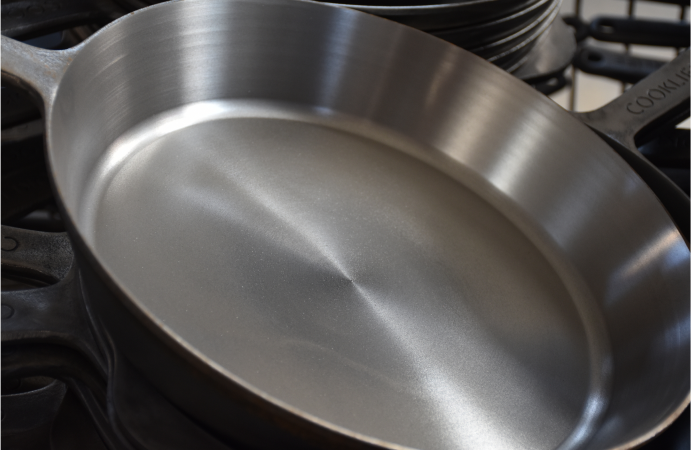What is Cast Iron?
Cast iron solidifies as a heterogeneous alloy, meaning it contains multiple constituents or materials in different phases within its micro-structure. This mixed micro-structure is what gives the various types of cast iron their distinctive physical properties. Specially, smelting iron-carbon alloys with a carbon content greater than 2% will produce the cast iron. It is known for its durability, heat retention, and versatility in various applications. The combination of high carbon content and the presence of silicon gives cast iron its excellent castability. Various cast irons are produced using different heat treatment and processing techniques, including gray iron, white iron, malleable iron, and ductile iron.
Gray Iron
Gray iron is characterized by the flake shape of the graphite molecules in the metal. When the metal is fractured, the break occurs along the graphite flakes, which gives it a gray color on the metal’s surface—the name gray iron comes from this characteristic. It typically contains 1-3% silicon and 2.5-4% carbon . Gray iron is not as ductile as other forms of cast iron, and the its tensile strength is also lower. However, it is a better thermal conductor has a higher level of vibration damping, and is superior to all other cast irons, which is why engine blocks, pipes, and cookware products make use of this material.
White Iron
White cast iron displays white fractured surfaces due to the presence of an iron carbide precipitate. It consists of 1.8-3.6% carbon and 0.5-1.9% silicon. They offer hardness at the expense of toughness. White iron is too brittle for use in many structural components, but with good hardness and abrasion resistance and relatively low cost, it finds use in such applications as billets for malleable cast iron and for making wear-resistant parts.
Ductile Iron
Ductile iron, or nodular iron, obtains its special properties through the addition of magnesium into the alloy. The presence of magnesium causes the graphite to form in a spheroid shape as opposed to the flakes of gray iron, the fracture face appears silver gray. It contains 3.2-3.6% carbon and 2.2-2.8% silicon. Ductile iron deforms on impact, rather than shattering into shards. Its impact profile makes it a good cast iron for bollards near vehicle traffic.
Malleable Iron
White iron can be further processed into malleable iron through the process of heat treatment. The slow process allows the surface tension to form the graphite into spheroidal particles rather than flakes. Malleable iron contains 2-3% carbon and 1-1.75% silicon. This process transforms the iron into a material that is more ductile and less brittle, making it ideal for applications requiring the resistance of shear force and machinability.
Specific heat treatments and cooling rates are involved in each type of processing technique to achieve the desired properties. Gray cast iron and ductile iron, for example, are usually cast in sand molds and subjected to various annealing treatments to improve their properties.
To Find the Best Choice of Cast Iron
As cast iron cookware, excellent heat conductivity with enhanced ductility and tensile strength is required. Cooklife uses high-quality modified gray cast iron to make the cookware, which is modified to achieve the fracture resistance of ductile cast iron without compromising on heat conductivity. The microscopic structure of modified gray cast iron provides greater tensile strength and toughness than ordinary gray cast iron, reducing the risk of cracking or fracture. Its superior performance makes it both safe and effective in cooking applications, ideal for cookware that is resistant to high temperatures and repeated use.
Modified gray cast iron is considered safer cookware because its stable structure is less likely to leach heavy metals into food than other types of cast iron. Its ability to withstand and maintain very high cooking temperatures makes it a common choice for searing or frying, and its excellent heat retention makes it a good option for long-cooking stews or braised dishes. Due to the thermal mass of gray cast iron, they can slow heating over a stovetop (or in an oven) lead to a more even temperature distribution, retain heat for a long time, and continue cooking food after the heat source has been removed, a very critical factor to consider for any celebrity chef or homemaker concerned with the love of traditional cooking methods.

Why is Cooklife Cast Iron Cookware So Great?
Cooklife's cast iron cookware offers many significant advantages owing to the use of high-quality modified gray cast iron. Even heat distribution and excellent heat retention make them ideal for slow cooking and drawing out the flavors from the food, letting the taste shine through. It is particularly beneficial for dishes such as stews, risotto, and roasts.
Moreover, the added durability that comes from applying modified gray cast iron means that Cooklife's cookware can be used over high heat on the stovetop (on gas, electric, glass, and induction burners!), in the oven, or even on the grill or over a campfire. Meanwhile, we use cast iron seasoning to protect bare cast iron from rust, provide a non-stick surface for cooking, and reduce food interaction with the iron of the pan. It enhances the cooking experience and makes cleaning easier.
Optimized traditional cast iron ingredients make Cooklife's cast iron cookware ideal for every home chef for a wide range of dishes, whether it's baking up a mean cornbread with crunchy or getting a ribeye with a crusty exterior and a rosy interior. An ode to simplicity, elegant, and lightweight but still sturdy, the cast iron skillet's excellent searing and maneuverability ensures that every dish is cooked to perfection, impressing seasoned cast iron skillet users and new-to-the-pan cooks alike.
Cast iron solidifies as a heterogeneous alloy, meaning it contains multiple constituents or materials in different phases within its micro-structure. This mixed micro-structure is what gives the various types of cast iron their distinctive physical properties.

